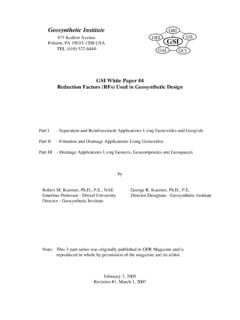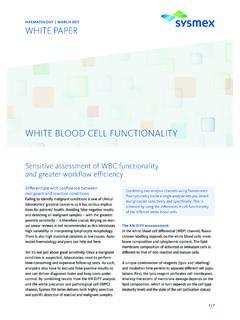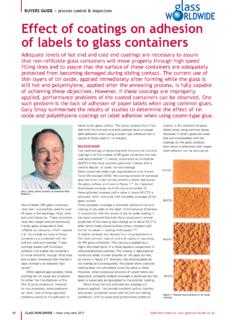Transcription of White Paper WP131001EN Effective May 2013 …
1 Effective May 2013 White Paper WP131001 ENGenerator circuit breakers have special requirements for generator protectionAbstractGenerator circuits experience conditions that are not common and are certainly more demanding than those experienced in normal distribution circuits. Generator circuits have unique characteristics that require circuit breakers specifically designed and tested for those conditions. To meet this need, the Switchgear Committee of the Institute of Electrical and Electronics Engineers (IEEET) developed and issued a special industry standard to address these unique characteristics. The specific IEEE Standard is , entitled IEEE Standard for AC High-Voltage Generator circuit Breakers Rated on a Symmetrical Current Basis and [1]This Paper summarizes unique and demanding aspects of protecting generator circuits and compares differences between the requirements for generator circuit breakers and those for standard distribution circuit breakers.
2 The superior performance capabilities of generator circuit breakers are summarized in a detailed, side-by-side comparison with the capabilities required of standard distribution circuit breakers. Finally, it will compare the existing standard against the dual logo standard 62271-37-013 performance and versatility are required of generator circuit breakers. Application possibilities continue to grow. The need for generator circuit breakers was first recognized by electric utilities to protect large generating stations, and the first editions of the industry standard were directed to this need. However, many industrial and commercial power systems now include small generators as a local source of power. New applications are arising as a result of the de-regulation of the utility industry, and the construction of smaller packaged power plants.
3 Typical applications include: Electric utility black start generators Packaged power plants Combined cycle/combustion turbine plants Pumped-storage facilities Smaller hydro-generating stations Process industries with on-site generationFor most generator circuit applications, consideration must be given to: Generator circuit configuration High continuous current levels Unique fault current conditions System-source (transformer-fed faults) Generator-source (generator-fed) faults Unique voltage conditions Very fast rate of rise of recovery voltage Out-of-phase switchingThe demanding service duty requirements for generator circuit breakers are discussed in the following paragraphs. Finally, a parameter-by-parameter comparison is made between the generator class circuit breaker and those of the distribution class circuit breaker , as outlined in applicable C37 standards.
4 Ruoss and Kolarik discussed the reasons for the development of the first industry standard for generator circuit breakers in 1993. [6] Finally, the Paper will review some of the additional and expected changes that will be required of generator circuit William Long Consultant Engineer EatonR. Kirkland Smith Manager EatonStephen M. Cary Principal Engineer Eaton2 White Paper WP131001 ENEffective May 2013 Generator circuit breakers have special requirements for generator protection eAton circuit configurationFigure 1 presents the single-line diagram of a common generator circuit . Although this circuit appears to be very simple, there are a number of critical factors to be considered. For example, generator circuits are typically designed for high efficiency in order to minimize the watts loss of the system. Therefore, the generator circuit breaker may be located very close to both the generator and the transformer, connected by short conductors with a large cross-section, resulting in minimal circuit with high continuous current levels require connections with very large conductors of very low impedance for optimum efficiency.
5 This circuit configuration and the operational nature of generator circuits can present special voltage and current conditions that must be addressed when applying circuit breakers in such continuous current levelsGenerator circuit breakers must be able to carry high continuous current levels for extended periods of time. Up to now, the existing generator circuit breaker standard has focused on larger generators . For example, it specifies a minimum continuous current rating of 6300A, up to 16 or 20 kA. This would obviously require some form of a continuous cooling system for the conductors, and the upper range of these currents would be considered fault current levels in most distribution circuits. In marked contrast, typical continuous current requirements for standard distribution circuits are usually between 3000A and 1200A, or these circuit breakers are cooled by natural convection of the ambient air.
6 Fan cooling has been a long accepted practice with power transformers and has become a popular solution in certain switchgear applications where the circuit is expected to carry higher than normal current, for short periods of time when demand is temporarily high. In most instances, however, fan cooling is not preferred. For some applications it is not acceptable, for reasons of increased maintenance, and possibly decreased reliability or availability, due to possible loss of fault current conditionsThe two key unique fault current conditions encountered by generator circuit breakers are shown in Figure BreakerStep-upTransformerGeneratorHigh VoltageCircuit BreakerFigure 1. Typical Generator circuit [1] Faults at location a are called System-source Faults or Transformer-fed Faults Faults at location b are called Generator-source Faults or Generator-fed Faults The differences between these two fault conditions become apparent when the important parameters of each are discussed transformer-fed fault current can be very high because the full energy of the power system feeds the fault.
7 The low impedance of the transformer and the short, very low-loss buses connecting the generator, generator circuit breaker , and transformer, do little to limit the fault current because of their very low impedance. To clear these kinds of faults, generator circuit breakers must be tested and proven capable of interrupting not only the high symmetrical fault current, but also the higher asymmetrical fault currents resulting from extreme DC components of fault current, up to 75% as required in Section of IEEE fault currents, while usually lower in magnitude, are subject to much higher degrees of asymmetry, sometimes resulting in another type of very demanding condition called Delayed Current Zeroes . This unique characteristic of the fault current comes from the very high X/R (inductive reactance to resistance) ratio of the circuit and the operating conditions of the generator, which can combine to produce a DC component of the fault current exceeding 100%.
8 This means the asymmetrical fault current peak becomes so high, and its decay becomes so slow, that the first current zero can be delayed for several cycles (see Figure 2).Because circuit breakers rely on a current zero crossing in order to interrupt, generator circuit breakers must be able to withstand longer arcing times and greater electrical, thermal, and mechanical stresses when clearing this kind of fault. Sections and of IEEE Standard require verification by test that the circuit breaker can interrupt under these extreme on the minimum opening time, the generator circuit breaker must demonstrate the ability to interrupt three-phase fault currents with DC components of 135% at one fault current level and of 110% with a higher fault current level, each time with the related delayed current zero. Kulicke and Schramm [7] were among the first to recognize the importance of the ability of the interrupter to withstand very long arcing times during the delayed current zero condition.
9 In particular, they demonstrated that vacuum interrupters are well suited to this requirement because they retain the ability to interrupt even after the contact motion has 2 4 60 20 40 60 80 100 120 140 160 Time After Fault Begins, T = Time in msContact PartingIdcFigure 2. Short- circuit Current with Delayed Current Zeroes [1]3 White Paper WP131001 ENEffective May 2013 Generator circuit breakers have special requirements for generator protection eAton voltage conditionsAs previously mentioned, in the typical generator circuit configuration, two large and very expensive components, each with a highly inductive impedance, are connected through the generator circuit breaker with very short conductors, of minimal resistance. Consequently, the resistance and stray capacitance of the generator circuit is typically much less than in a normal distribution circuit .
10 These characteristics combine to produce very high natural frequencies of the circuit and in turn result in extreme Transient Recovery Voltages (TRV) with high Rates of Rise of Recovery Voltage (RRRV).This means that during the interruption, just after the interrupter has been subjected to a 50,000 degree plasma arc, it must re-establish dielectric strength across the open gap in order to withstand this fast-rising TRV. In the first phase to clear, the peak value of this TRV is nearly double the line-to-line voltage of the circuit , and the circuit produces that peak voltage within microseconds following the current zero. If the interrupter is able to withstand that fast-rising voltage, then the interruption is successful. If not, the gap will break down again, and the fault current will continue to flow until the next current zero, when there will be another opportunity to interrupt.

















